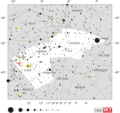Top Qs
Timeline
Chat
Perspective
NGC 3576
Emission nebula in the constellation Carina From Wikipedia, the free encyclopedia
Remove ads
NGC 3576 is a bright emission nebula and star-forming region in the southern constellation of Carina. It was discovered by John Frederick William Herschel on 16 March 1834.[5] Distance estimates for this complex range from 7.8[2] to 9.8 thousand light-years.[3]
Remove ads
Observations
This complex is located near the galactic plane along the Carina arm of the Milky Way galaxy.[3] It is approximately 100 light years across and is located near the Eta Carinae nebula,[6] forming the western section of RCW 57.[7] NGC 3576 consists of a giant, star-forming molecular cloud with a luminous H II region positioned just outside.[8] In the infrared, this is one of the brightest H II regions in the galaxy.[9] It is expanding into the molecular cloud and appears to be triggering further star formation.[10] Most of the ionization is believed to be due to two O-type stars, HD 97319 and HD 97484, and two B-type stars, HD 974999 and CPD–60◦2641.[7]
Many of the brightest stars in this formation are still enshrouded in their natal cocoons of gas and dust.[3] A majority of the stars display an infrared excess from the surrounding circumstellar disks.[3] Star formation appears to be progressing in a direction from the northeast to the southwest, with the youngest stars in the latter locale.[3] A very young cluster of massive stars with 130 identified members is embedded deep within the molecular cloud.[2]
Remove ads
Gallery
- The location of NGC 3576 (circled in red)
- NGC 3576 in Hubble Palette by amateur astronomer Mark Johnston
References
Further reading
External links
Wikiwand - on
Seamless Wikipedia browsing. On steroids.
Remove ads



